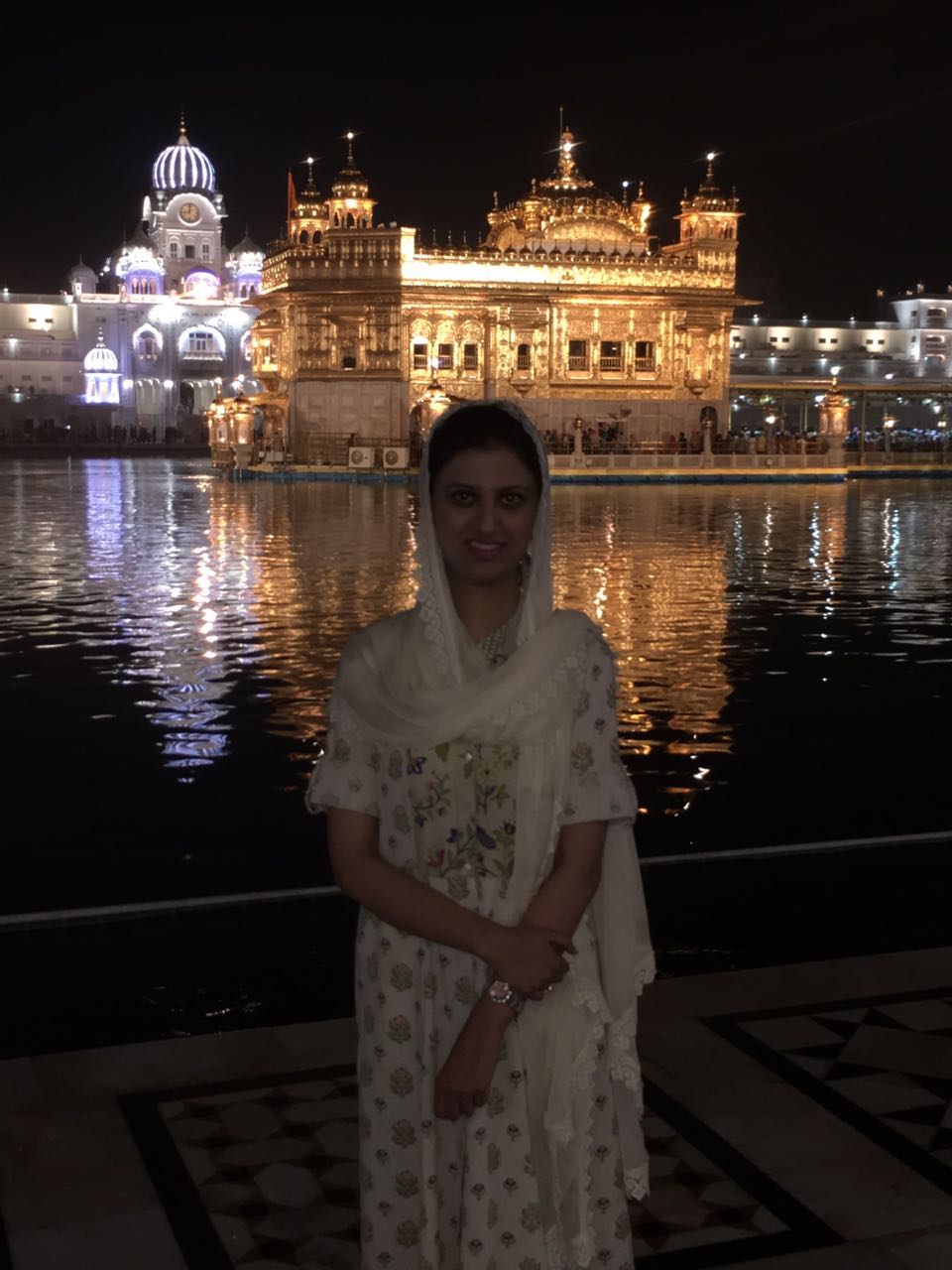One of the must visit place in Amritsar is the Sri Darbar Sahib, commonly known as the Golden Temple. This is the holiest temple in the Sikh faith.
History of Sri Darbar Sahib ( Golden Temple)
Guru Ramdas Sahib, the 4th of 10 Sikh gurus, constructed the temple and its pool in the 1500s as a place of worship for all.
The architecture of Sri Darbar Sahib Amritsar ( The Golden Temple) was designed by Guru Arjan Dev ji . he wanted to build a central place for the worship for all sikhs and so this temple was made. The planning to excavate the holy tank or Amrit sarovar was chalked out by the third Nanak Guru AmarDas ji but it was executed by Guru Ram Das ji. The land for this site was acquired by the earler Guru Sahibs on payment or for free from the Zamindars on native villages. , the construction work on the Sarovar (the tank) and the town started simultaneously in 1570.
The main structure of the the golden temple is a three storied building. The front, which faces the bridge, is decorated with repeated cusped arches and the roof of the first floor is at the height of the 26 feet and 9 inches.
At the top of the first floor 4 feet high parapet rises on all the sides which has also four ‘Mamtees’ on the four corners and exactly on the top of the central hall of the main sanctuary rises the third story.
It is a small square room and has three gates. A regular recitation of Guru Granth Sahib is also held there. On the top of this room stands the low fluted ‘Gumbaz’ (dome) having lotus petal motif in relief at the base inverted lotus at the top which supports the “Kalash” having a beautiful “Chhatri” at the end.
The architecture of The Golden Temple is considered one of the best in the world. It is often quoted that this architecture has created an independent Sikh school of architecture in the history of art in India.
Early Attacks on Golden Temple (17 and 18th Century )
Sri Darbar Sahib Amritsar (The Golden Temple Amritsar) was damaged multiple times during Afghan invasions in the 18th century.
One of the most tragic incidents was the Operation Blue Star in June 1984. The Indian Army conducted a military operation to flush out Sikh militants who had fortified themselves inside the Gurudwara complex. The operation resulted in significant damage to the Gurudwara and loss of lives, including civilians.
Daily Routine at Sri Darbar Sahib Amritsar (The Golden Temple Amritsar)
Gubani Kirtan is continuously sung at the Sri Darbar Sahib from the opening of its door till closing time. After the the departure of the Palki Sahib (palanquin) carrying Guru Granth Sahib to The Akal Takhat Sahib, the devotees, accompanied by the Guru Granth Sahib staff, clean the Sri Darbar Sahib for one hour.
After the purification of the precincts, the rugs are spread and peer Sahib is placed on which the Guru Granth Sahib is placed early in the morning. After the completion of the Ardas (Sikh Prayer) , Karah Prasad is distributed among the devotees.
At Akal Takht, after the Rehras (Evening Scripture) the weapons belonging to Guru Sahib (Sikh Masters) and Martyr Sikhs are displayed at about 8.00 p.m.
Visiting Hours of Golden Temple
Sri Darbar Sahib Amritsar (The Golden Temple Amritsar) is open to visitors 24 hours a day, 7 days a week. However, the main prayer ceremonies and the best times to visit are during the early morning hours and in the evening.
Dress Code inside the Golden Temple
Visitors are required to dress modestly while visiting Sri Darbar Sahib Amritsar (The Golden Temple Amritsar). Both men and women should cover their heads with scarves or other head coverings. Shorts, skirts, and sleeveless tops are not allowed inside the main complex.
Tips to Travel at Golden Temple
At every entrance to the Golden Temple there is a provision to keep your shoes and luggage free of cost. One must take the token after depositing the belongings
Wash your feet/hands, and cover your head properly before entering the Golden Temple
Anyone can take a dip in the holy Sarovar but use of soap or shampoo is not allowed.
It is strictly prohibited to serve or eat any eatables in the Parikrama, or to loiter about with uncovered head.
Places to Visit in The Golden Temple
Hukamnama ( order of the day )
Hukamnama refers to a divine order or commandment that is considered a message from the Guru to the Sikh community. It holds great significance and is an integral part of Sikh religious practices.
Everyday early in the morning 1 person is chosen from the Gurudwara staff or the sikh community and they enter the the sanctum santorum of Sri Darbar Sahib. The person known as the grathi or Gianai opens the Guru Granth Sahib the holy scripture of Sikhism at a random page.
The Granthi then reads the verse on hyme written on that page. This verse or hymn is considered the Hukamnama of the day, It is considered a direct message from the Guru and holds spiritual guidance and wisdom for the Sikh community. It is believed that the verse or hymn revealed in the Hukamnama holds deep meaning and relevance to the current circumstances and the individual’s spiritual journey. Sikhs often reflect on the Hukamnama and strive to incorporate its teachings into their daily lives.
Guru ka Langar ( community kitchen )
It is the largest in the world and serves 1 lakh people a day. Guru Ka Langar The tradition of serving langar Initiated by Guru Nanak Dev Ji and then established by the 3rd Guru Sri Guru Amar Dass Ji at Goindwal.
Akal Takht
The word ‘Akal’ means, time-less (often used for Almighty-God) Takhat means a throne (seat) where the kings, emperors used to sit. Hence Akal Takhat : the seat of Almighty.
After the excavation of the Amrit Sarovar , a raised place had appeared in front of Darbar Sahib. The Guru Granth Shib was brought to rest every night in this room. Guru Arjan Dev used to rest under the cot meant for Guru Granth Sahib. This room now a days is, known as Kotha Sahib.Akal Takhat has its own traditions i.e. the priest will recite the evening prayer (Rehras Sahib) and Ardas, with a naked sword in the hand. Some rare weapons pertaining to the Sikh Gurus and Sikh warriors are displayed during the day in Golden Palanquin and explained to the visitors every evening.
Central Sikh Museum
It was established in 1958. it has paintings of Sikh gurus, saints, Sikh warriors and other prominent Sikh leaders who have contributed to the enhancement of Sikh religion. It has a rich collection of coins, old arms and ancient manuscripts. The wooden comb (kangha) of Guru Gobind Singh, arrows and bow, iron chakras (circles) to be worn on the turban by warrior and an iron jacket made of wires (sanjoe) are worth seeing.
How to reach Golden Temple
There are direct flights from almost all the cities of India to Amritsar. From the airport you can directly take a taxi , auto or bus to the Golden Temple.
There are also trains on a dialy basis which reach Amritsar and you can easily book the train and from the railway station you can take taxi, auto or bus to the Golden Temple.
There are many roadway buses also which run daily to Amritsar . One can easily book the tickets online for these buses.
Where to stay in Amritsar
There are many hotels and lodges available in Amritsar in a variety of price range. You can easily book any of these as per your convenience and they can also help you with taxi service to reach the Golden Temple.
There is accommodation facility available in the Golden Temple area as well.
There are seven Niwas Asthans (inns) which provide lodging facilities for pilgrims, maintained by Sri Harimandir Sahib authorities. The reception counters work round the clock to attend to the devotees.
Note : The booking office for all accommodations is situated in Sri Guru Arjan Dev Niwas.
Conclusion
Plan your visit to the Golden Temple and submerge yourself in the grandeur and beauty of the temple. Sit near the Sarovar area and experience the peace and calm. This feeling can only be experienced once you visit the place and words will not do justice to it. So go ahead and Lets enjoy one day at a time!

